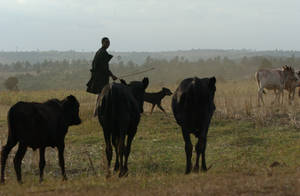FAO, O IE and WHO unite in their goal to eliminate human rabies and control the disease in animals.
IE and WHO unite in their goal to eliminate human rabies and control the disease in animals.
Every year, an estimated 60 000 people die an agonizing death from rabies, many of whom are children bitten by rabies-infected dogs. Rabies is preventable!
Awareness and education
Community participation, education and public awareness are important elements of successful rabies control programmes, and mass vaccination of dogs is critical. Communities need to take responsibility for their dogs, prevent dog bites and know what to do when bitten.
Break the cycle
More than 100 countries report cases of rabies in dogs putting people at risk. Vaccinating at least 70% of dogs breaks the cycle of transmission in dogs and to humans. Rabies programmes need to incorporate free-roaming and street dogs with options for dog population management.
Safe, efficacious and affordable dog rabies vaccine are available, and countries embarking on rabies elimination need easy access to quality-assured dog vaccines for vaccination campaigns and for outbreak management. Vaccine banks can help facilitate procurement and deliveries.
When a person is bitten
A person who is bitten by a rabid animal still has the chance to survive if the wound is cleaned immediately and thoroughly with plenty of water and soap and post-exposure prophylaxis is provided in time (a course of vaccines and, in severe cases, immunoglobulins).
Preventive rabies vaccination can be given to people at high risk of exposure from domestic or wild animals, such as animal health workers, veterinarians or laboratory personnel, to protect them before they are exposed.
Surveillance to guide action
Surveillance is an important pillar to understand trends and to guide action in rabies elimination. Disease reporting is essential for identifying risk areas and providing assurance of absence of disease. Laboratory capacity is critical to confirm cases and requires strengthening in many parts of the world.
Not just dogs
Besides addressing rabies in dogs, rabies transmitted by wildlife also requires attention. In a few regions of the world, rabies transmitted by wildlife has become the most prominent pathway for human rabies transmission, for example bat-transmitted rabies in South America. Changes in the environment and closer human contact with wildlife can lead to increased human exposure to rabies-infected wildlife species.
Livestock can become infected with rabies by dogs or wildlife, resulting in economic losses and impacting food security.
Collaboration across sectors
Elimination of rabies requires consistent and sustained commitment, underpinned by strong health and veterinary systems.
Different sectors and disciplines need to collaborate closely, and World Rabies Day is an opportunity to establish or strengthen these links. Regional elimination of human rabies transmitted by dogs has been outlined by Latin American countries for 2015 and south-east Asia for 2020.
FAO, OIE and WHO are working together to raise global awareness and commitment to step-up the fight against rabies.
 IE and WHO unite in their goal to eliminate human rabies and control the disease in animals.
IE and WHO unite in their goal to eliminate human rabies and control the disease in animals.Every year, an estimated 60 000 people die an agonizing death from rabies, many of whom are children bitten by rabies-infected dogs. Rabies is preventable!
Awareness and education
Community participation, education and public awareness are important elements of successful rabies control programmes, and mass vaccination of dogs is critical. Communities need to take responsibility for their dogs, prevent dog bites and know what to do when bitten.
Break the cycle
More than 100 countries report cases of rabies in dogs putting people at risk. Vaccinating at least 70% of dogs breaks the cycle of transmission in dogs and to humans. Rabies programmes need to incorporate free-roaming and street dogs with options for dog population management.
Safe, efficacious and affordable dog rabies vaccine are available, and countries embarking on rabies elimination need easy access to quality-assured dog vaccines for vaccination campaigns and for outbreak management. Vaccine banks can help facilitate procurement and deliveries.
When a person is bitten
A person who is bitten by a rabid animal still has the chance to survive if the wound is cleaned immediately and thoroughly with plenty of water and soap and post-exposure prophylaxis is provided in time (a course of vaccines and, in severe cases, immunoglobulins).
Preventive rabies vaccination can be given to people at high risk of exposure from domestic or wild animals, such as animal health workers, veterinarians or laboratory personnel, to protect them before they are exposed.
Surveillance to guide action
Surveillance is an important pillar to understand trends and to guide action in rabies elimination. Disease reporting is essential for identifying risk areas and providing assurance of absence of disease. Laboratory capacity is critical to confirm cases and requires strengthening in many parts of the world.
Not just dogs
Besides addressing rabies in dogs, rabies transmitted by wildlife also requires attention. In a few regions of the world, rabies transmitted by wildlife has become the most prominent pathway for human rabies transmission, for example bat-transmitted rabies in South America. Changes in the environment and closer human contact with wildlife can lead to increased human exposure to rabies-infected wildlife species.
Livestock can become infected with rabies by dogs or wildlife, resulting in economic losses and impacting food security.
Collaboration across sectors
Elimination of rabies requires consistent and sustained commitment, underpinned by strong health and veterinary systems.
Different sectors and disciplines need to collaborate closely, and World Rabies Day is an opportunity to establish or strengthen these links. Regional elimination of human rabies transmitted by dogs has been outlined by Latin American countries for 2015 and south-east Asia for 2020.
FAO, OIE and WHO are working together to raise global awareness and commitment to step-up the fight against rabies.





